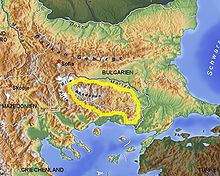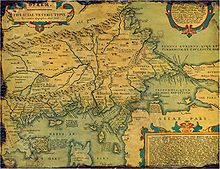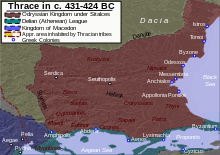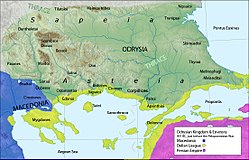Thrace(/θreɪs/,thrayss;Bulgarian:Тракия,romanized:Trakiya;Greek:Θράκη,romanized:Thráki;Turkish:Trakya) is a geographical and historical region inSoutheast Europe.Bounded by theBalkan Mountainsto the north, theAegean Seato the south, and theBlack Seato the east, it comprises present-day southeastern Bulgaria (Northern Thrace), northeastern Greece (Western Thrace), and the European part of Turkey (East Thrace), roughly the Roman Province of Thrace. Lands also inhabited by ancientThraciansextended in the north to modern-dayNorthern BulgariaandRomaniaand to the west intoMacedonia.







Etymology
editThe wordThrace,fromancient GreekThrake(Θρᾴκη),[1]referred originally to theThracians(ancient GreekThrakesΘρᾷκες),[2]an ancient people inhabiting Southeast Europe. The nameEurope(ancient Greek Εὐρώπη), also at first referred to this region, before that term expanded to include itsmodern sense.[3][4]The region could have been named after the principal river there,Hebros,possibly from the Indo-Europeanarg"white river" (the opposite ofVardar,meaning "black river" ),[5]According to an alternative theory, Hebros means "goat" inThracian.[6]
According toStephanus of Byzantium,long before the ancient Greeks started referring to the region asThrace,it was known as Aria (Αρια) and Perki (Περκη).[7][8]
In Turkey, it is commonly referred to asRumeli,"Land of the Romans", which was the name traditionally given by Turkic societies to theByzantine EmpireandOrthodox Christians.
Mythology
editIn terms of ancient Greek mythology the name appears to derive from the heroine and sorceressThrace,who was the daughter ofOceanusand Parthenope, and sister ofEuropa.
Geography
editBorders
editThe historical boundaries of Thrace have varied. Theancient Greeksemployed the term "Thrace" to refer to all of the territory which lay north ofThessalyinhabited by theThracians,[9]a region which "had no definite boundaries" and to which other regions (likeMacedoniaand evenScythia) were added.[10]In one ancient Greek source, the very Earth is divided into "Asia, Libya, Europa and Thracia".[10]As the Greeks gained knowledge of world geography, "Thrace" came to designate the area bordered by theDanubeon the north, by the Euxine Sea (Black Sea) on the east, by northern Macedonia in the south, and byIllyriato the west.[10]This largely coincided with the ThracianOdrysian kingdom,whose borders varied over time. After the Macedonian conquest, this region's former border with Macedonia was shifted from theStruma Riverto theMesta River.[11][12]This usage lasted until the Roman conquest. Henceforth, (classical) Thrace referred only to the tract of land largely covering the same extent of space as the modern geographical region.[clarification needed]In its early period, theRoman province of Thracewas of this extent, but after the administrative reforms of the late 3rd century, Thracia's much reduced territory became the six small provinces which constituted theDiocese of Thrace.The medievalByzantinetheme of Thracecontained only what today isEast Thrace.
Cities
editThe largest cities of Thrace are:Istanbul,Plovdiv,Çorlu,Tekirdağ,Burgas,Edirne,Stara Zagora,Sliven,Yambol,Haskovo,Komotini,Alexandroupoli,Xanthi,andKırklareli.
Demographics and religion
editMost of theBulgarianandGreekpopulation areOrthodox Christians,while most of theTurkishinhabitants of Thrace areSunniMuslims.
Ancient Greek mythology
editAncient Greek mythologyprovides the Thracians with a mythical ancestorThrax,the son of the war-godAres,who was said to reside in Thrace. The Thracians appear inHomer'sIliadasTrojanallies, led byAcamasandPeiros.Later in theIliad,Rhesus,another Thracian king, makes an appearance.Cisseus,father-in-law to the Trojan elderAntenor,is also given as a Thracian king.
Homeric Thrace was vaguely defined, and stretched from the RiverAxiosin the west to theHellespontandBlack Seain the east. TheCatalogue of Shipsmentions three separate contingents from Thrace: Thracians led by Acamas and Peiros, fromAenus;Ciconesled byEuphemus,from southern Thrace, nearIsmaros;and from the city ofSestus,on the Thracian (northern) side of the Hellespont, which formed part of the contingent led byAsius.Ancient Thrace was home to numerous other tribes, such as theEdones,Bisaltae,Cicones,andBistonesin addition to the tribe that Homer specifically calls the "Thracians".
Greek mythologyis replete with Thracian kings, includingDiomedes,Tereus,Lycurgus,Phineus,Tegyrius,Eumolpus,Polymnestor,Poltys,andOeagrus(father ofOrpheus).
Thrace is mentioned inOvid'sMetamorphoses,in the episode ofPhilomela,Procne,andTereus:Tereus, the King of Thrace, lusts after his sister-in-law, Philomela. He kidnaps her, holds her captive, rapes her, and cuts out her tongue. Philomela manages to get free, however. She and her sister, Procne, plot to get revenge, by killing her sonItys(by Tereus) and serving him to his father for dinner. At the end of the myth, all three turn into birds – Procne into aswallow,Philomela into anightingale,and Tereus into ahoopoe.
The city ofDicaeain Thrace was named after the son ofPoseidon,Dicaeus.[13]
History
editAncient and Roman history
editIndigenousThracianswere divided into numerous tribes. The first to take greater control of Thrace, in part or whole, were theAchaemenianPersiansin the late6th century BC.The region was incorporated into their empire as theSatrapy of Skudra,after theScythian campaign of Darius the Great.[14]Thracian soldiers were used in Persian armies and are depicted in carvings of thePersepolisandNaqsh-e Rostam.Persians' presence in Thracia lasted for more than a century, ending with the conquests in the4th century BCbyAlexander the Great of Macedon,who divided the vast realm between his generals. Notably, Thracian troops are known to have accompanied Alexander when he crossed theHellespontwhich abuts Thrace, during the invasion of thePersian Empireitself.
The Thracians recorded no collective name for themselves; terms such asThraceandThracianswere assigned by the Greeks.[15]
Divided into separate tribes, the Thracians did not form any lasting political organizations until the founding of theOdrysian statein the 4th century BC. LikeIllyrians,the locally ruled Thracian tribes of the mountainous regions maintained a warrior tradition, while the tribes based in the plains were purportedly more peaceable. Recently discovered funeral mounds in Bulgaria suggest that Thracian kings did rule regions of Thrace with distinct Thracian national identity.[citation needed]
During this period, a subculture ofcelibateasceticscalled theCtistaelived in Thrace, where they served as philosophers, priests, and prophets.
Sections of Thrace particularly in the south started to become hellenized before thePeloponnesian Waras Athenian and Ionian colonies were set up in Thrace before the war. Spartan and otherDoriccolonists followed them after the war. The special interest of Athens to Thrace is underlined by the numerous finds of Athenian silverware in Thracian tombs.[16]In 168 BC, after theThird Macedonian warand the subjugation of Macedonia to the Romans, Thrace also lost its independence and became tributary to Rome. Towards the end of the 1st century BC Thrace lost its status as a client kingdom as the Romans began to directly appoint their kings.[17]This situation lasted until 46 AD, when the Romans finally turned Thrace into a Roman province (Romana provincia Thracia).[18]
During the Roman domination, within the geographical borders of ancient Thrace, there were two separate Roman provinces, namely Thrace ( "provincia Thracia" ) and Lower Moesia ( "Moesia inferior" ). Later, in the times of Diocletian, the two provinces were joined and formed the so-called "Dioecesis Thracia".[19]The establishment of Roman colonies and mostly several Greek cities, as was Nicopolis, Topeiros, Traianoupolis, Plotinoupolis, and Hadrianoupolis resulted from the Roman Empire's urbanization. The Roman provincial policy in Thrace favored mainly not the Romanization but the Hellenization of the country, which had started as early as the Archaic period through the Greek colonisation and was completed by the end of Roman antiquity.[20]As regards the competition between the Greek and Latin language, the very high rate of Greek inscriptions in Thrace extending south ofHaemus Mountainsproves the complete language Hellenization of this region. The boundaries between the Greek and Latin speaking Thrace are placed just above the northern foothills of Haemus Mountains.[21]
During the imperial period many Thracians – particularly members of the local aristocracy of the cities – had been granted the right of theRoman citizenship(civitas Romana) with all its privileges. Epigraphic evidence show a large increase in such naturalizations in the times of Trajan and Hadrian, while in 212 AD the emperor Caracalla granted, with his well-known decree (constitutio Antoniniana), the Roman citizenship to all the free inhabitants of the Roman Empire.[22] During the same period (in the 1st-2nd century AD), a remarkable presence of Thracians is testified by the inscriptions outside the borders (extra fines) both in the Greek territory[23]and in all the Roman provinces, especially in the provinces of Eastern Roman Empire.[24]
Medieval history
editBy the mid-5th century, as theWestern Roman Empirebegan to crumble, Thracia fell from the authority of Rome and into the hands of Germanic tribal rulers. With the fall of the Western Roman Empire, Thracia turned into a battleground territory for the better part of the next 1,000 years. The surviving eastern portion of theRoman Empirein the Balkans, later known as theByzantine Empire,retained control over Thrace until the 7th century when the northern half of the entire region was incorporated into theFirst Bulgarian Empireand the remainder was reorganized in theThracian theme.The Empire regainedthe lost regions in the late 10th century until the Bulgarians regained control of the northern half at the end of the 12th century. Throughout the 13th century and the first half of the 14th century, the region was changing in the hands of the Bulgarian and the Byzantine Empire (excluding Constantinople). In 1265 the area suffered a Mongol raid from theGolden Horde,led byNogai Khan,and between 1305 and 1307 was raided by theCatalan company.[25]
Ottoman period
editIn 1352, theOttomanTurksconducted their first incursion into the regionsubduing itcompletely within a matter of two decades and ruled it for five centuries in general peace. In 1821, several parts of Thrace, such asLavara,Maroneia,Sozopolis,Aenos,Callipolis,andSamothrakirebelled during theGreek War of Independence.
Modern history
editWith theCongress of Berlinin 1878, Northern Thrace was incorporated into the semi-autonomous Ottoman province ofEastern Rumelia,which united with Bulgaria in 1885. The rest of Thrace was divided amongBulgaria,TurkeyandGreeceat the beginning of the 20th century, following theBalkan Wars,World War Iand theGreco-Turkish War.In Summer 1934, up to 10,000 Jews[26]were maltreated, bereaved,[clarification needed]and then forced to quit the region (see1934 Thrace pogroms). FromBulgariaandRomaniabetween 1934 and 1938 a large wave ofMuslimsimmigrants calledGöçmenlerwent toEast Thrace.[27]
Today,Thracianis a geographical term used inBulgaria,Turkey,andGreece.
Notable Thracians
edit- Orpheuswas, inAncient Greek mythology,the chief representative of the art of song and playing thelyre.
- Protagoraswas a Greek philosopher fromAbdera, Thrace(c. 490–420 BC.) An expert inrhetoricsand subjects connected to virtue and political life, often regarded as the firstsophist.He is known primarily for three claims: (1) that man is the measure of all things, often interpreted as a sort ofmoral relativism,(2) that he could make the "worse (or weaker) argument appear the better (or stronger)" (seeSophism), and (3) that one could not tell if the gods existed or not (seeAgnosticism).
- Herodicuswas a Greek physician of the fifth century BC who is considered the founder ofsports medicine.He is believed to have been one ofHippocrates' tutors.
- Democrituswas a Greek philosopher and mathematician fromAbdera, Thrace(c. 460–370 BC.) His main contribution is theatomic theory,the belief that all matter is made up of various imperishable indivisible elements which he calledatoms.
- Spartacuswas a Thracian who led a large slave uprising in what is now Italy in 73–71 BC. His army of escapedgladiatorsand slaves defeated severalRoman legionsin what is known as theThird Servile War.
- A number ofRoman emperorsof the 3rd–5th century were ofThraco-Romanbackgrounds (Maximinus Thrax,Licinius,Galerius,Aureolus,Leo the Thracian,etc.). These emperors were elevated via a military career (hence the resultant nickname for them,Barracks Emperor), from the condition of common soldiers in one of theRoman legionsto the foremost positions ofpolitical power.
Legacy
editTheTrakiya HeightsinAntarctica"are named after the historical region."[28]
See also
editNotes
edit- ^Θρᾴκη.Liddell, Henry George;Scott, Robert;A Greek–English Lexiconat thePerseus Project
- ^Θρᾷξ.Liddell, Henry George;Scott, Robert;A Greek–English Lexiconat thePerseus Project
- ^"Greek goddess Europa adorns new five-euro note".BBC News.January 10, 2013.
- ^Pagden, Anthony (2002)."Europe: Conceptualizing a Continent"(PDF).In Pagden, Anthony (ed.).The idea of Europe: from antiquity to the European Union.Washington, DC; Cambridge; New York: Woodrow Wilson Center Press; Cambridge University Press.doi:10.1017/CBO9780511496813.ISBN9780511496813.Archived(PDF)from the original on 2022-10-09.
- ^Pieter, Jan (1989).Thracians and Mycenaeans: Proceedings of the Fourth International Congress.Brill Archive.ISBN978-9004088641.
- ^"The Plovdiv Project".
- ^Stephanus Of Byzantium - Ethnica,Theta 316.9
- ^Billerbeck, Margarethe (2010).Stephanus von Byzanz: Stephani Byzantii Ethnica / Delta - Iota(in German). pp. Theta.ISBN978-3111738505.
- ^Swinburne Carr, Thomas (1838).The history and geography of Greece.Simpkin, Marshall & Company. p.56.
- ^abcSmith, Sir William (1857).Dictionary of Greek and Roman geography.London: Little, Brown and Company. p. 1176.
- ^Johann Joachim Eschenburg, Nathan Welby Fiske (1855).Manual of classical literature.E.C. Biddle. p.20n.
- ^Adam, Alexander (1802).A summary of geography and history, both ancient and modern.A. Strahan. p.344.
- ^Stephanus of Byzantium, Ethnica, §D230.
- ^Joseph Roisman, Ian Worthington."A companion to Ancient Macedonia"John Wiley & Sons, 2011.ISBN144435163Xp 343
- ^TheCambridge Ancient History,Volume 3, Part 2: The Assyrian and Babylonian Empires and Other States of the Near East, from the Eighth to the Sixth Centuries BC by John Boardman, I. E. S. Edwards, E. Sollberger, and N. G. L. Hammond,ISBN0-521-22717-8,1992, page 597: "We have no way of knowing what the Thracians called themselves and if indeed they had a common name...Thus the name of Thracians and that of their country were given by the Greeks to a group of tribes occupying the territory..."
- ^A. Sideris,Theseus in Thrace. The Silver Lining on the Clouds of the Athenian-Thracian Relations in the 5th Century BC(Sofia 2015), pp. 13-14, 79-82.
- ^D. C. Samsaris, Le royaume client thrace aux temps de Tibere et la tutelle romaine de Trebellenus Rufus (Le stade transitif de la clientele a la provincialisation de la Thrace), Dodona 17 (1), 1988, p. 159-168
- ^[1]D. C. Samsaris, The Hellenization of Thrace during the Greek and Roman Antiquity (Diss. in Greek), Thessaloniki 1980, p. 26-36
- ^D. C. Samsaris, Historical Geography of Western Thrace during the Roman Antiquity (in Greek), Thessaloniki 2005, p. 7-14
- ^[2]D. C. Samsaris, The Hellenization of Thrace, passim
- ^[3]D. C. Samsaris, The Hellenization of Thrace, p. 320-330
- ^D. C. Samsaris, Surveys in the history, topography and cults of the Roman provinces of Macedonia and Thrace (in Greek), Thessaloniki 1984, p. 131-302
- ^D. C. Samsaris, Les Thraces dans l' Empire romain d' Orient (Le territoire de la Grèce actuelle). Etude ethno-démographique, sociale, prosopographique et anthroponymique, Jannina (Université) 1993, pp. 372
- ^D. C. Samsaris, Les Thraces dans l' Empire romain d' Orient (Asie Mineure, Syrie, Palestine et Arabie). Etude ethno-démographique et sociale, VIe Symposium Internazionale di Tracologia (Firenze 11-13 maggio 1989), Roma 1992, p. 184-204 [= Dodona 19(1990), fasc. 1, p. 5-30]
- ^La Venjança catalana.Gran Enciclopèdia Catalana.
- ^seefootnote 4
- ^https://www.historystudies.net/trakyanin-yeni-sakinleri-gocmenler-1934-1938_1634
- ^Trakiya Heights.SCARComposite Antarctic Gazetteer.
References
edit- Hoddinott, R. F.,The Thracians,1981.
- Ilieva, Sonya,Thracology,2001
External links
edit- Ethnological Museum of Thrace,comprehensive website on Thracian history and culture.
- [4]Archived2021-05-10 at theWayback MachineBulgaria's most famous Thracian Treasure - The Panagyurishte Gold Treasure to return home after two years lapse
- Bulgaria's Thracian Heritage.including images of the comprehensive art collection of Thracian gold found on the territory of contemporary Bulgaria.
- Information on Ancient Thrace
- The People of the God-Sun Ar and Areia (modern Thrace)The People of the God-Sun Ar and Areia (Modern Thrace)
- Possible Orphic Lyre rock engraving discovered in Bulgaria's Eastern Rhodope MountainsArchived2021-05-10 at theWayback Machine